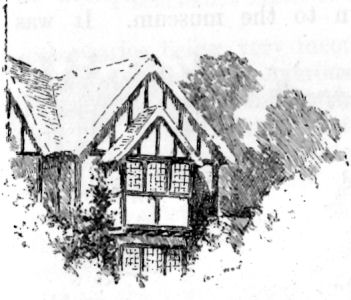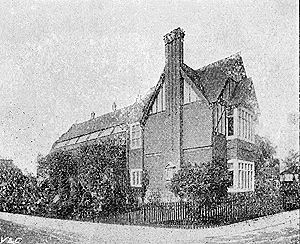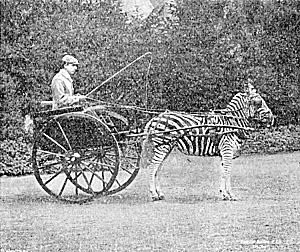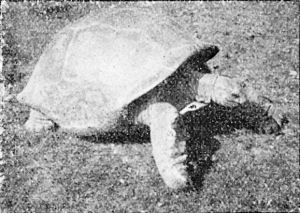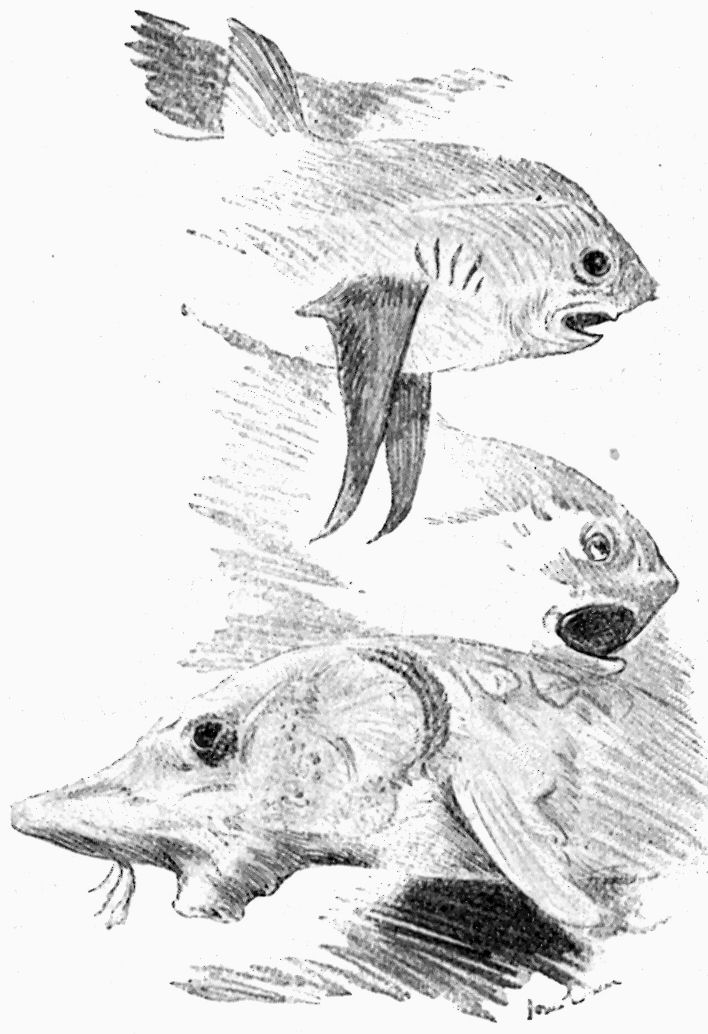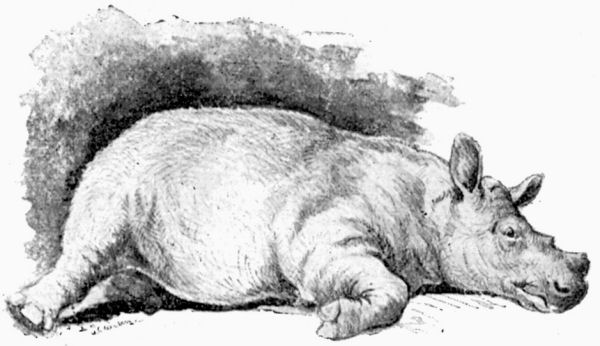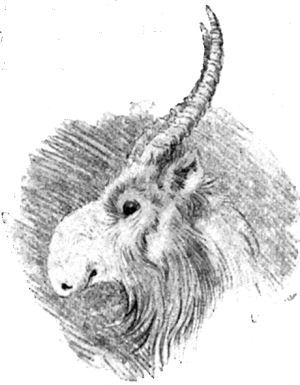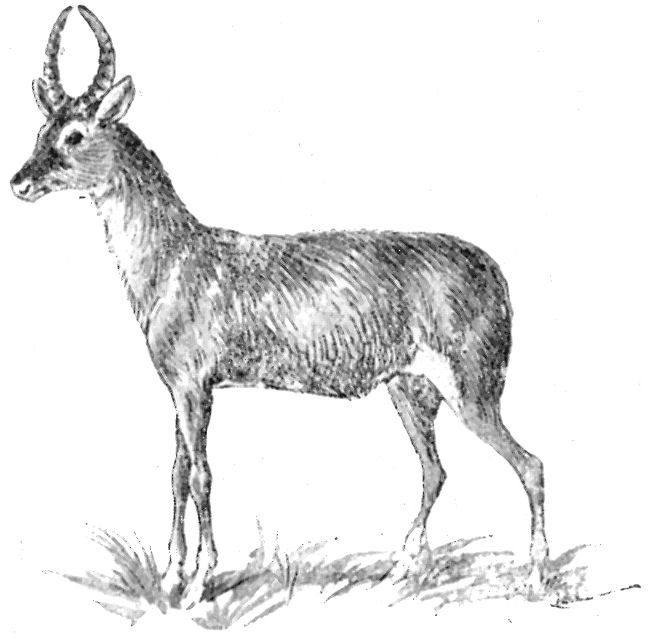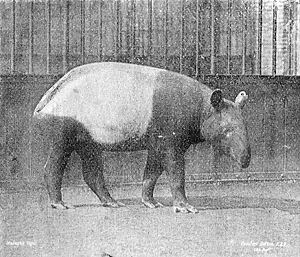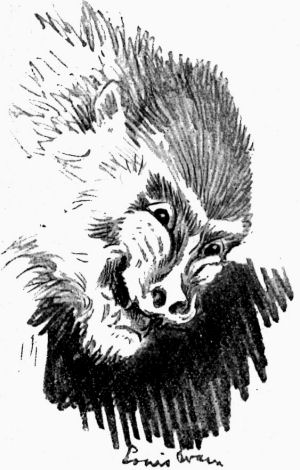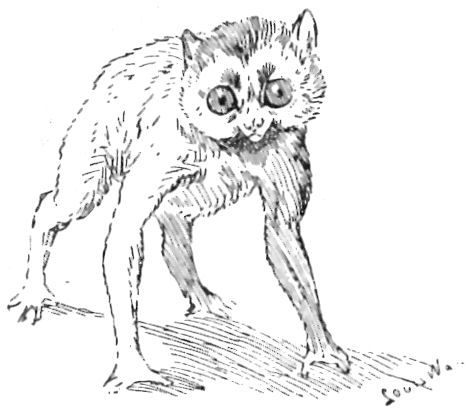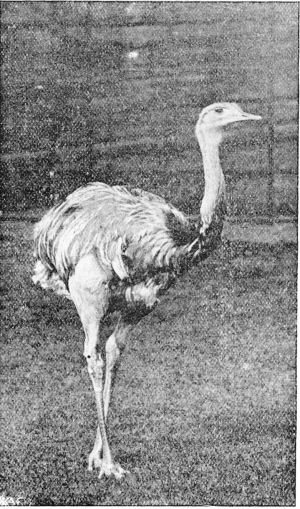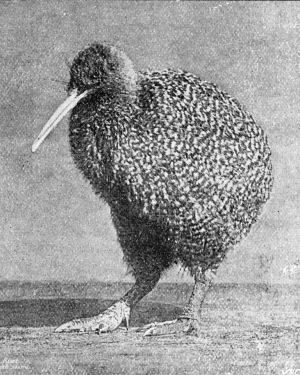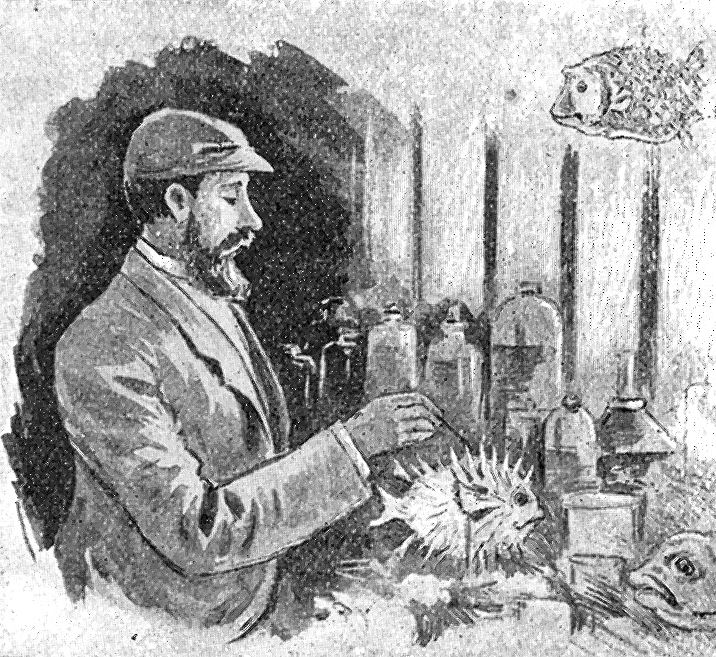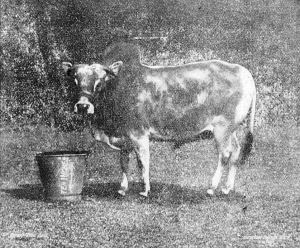|
|
Louis Wain visits TRING Museum in 1895 |
|
|
The Hon. Walter Rothschild's Pets A Visit to Tring Museum by Louis Wain The Windsor Magazine, 1895 |
||
|
Tring House |
||
|
MIST glooms, steeping the hills drearily in chill watery vapours, pass away in rolling undulations before the heat of the early morning sun leaying the small rural town of 'l'ring clear cut against a wooded background. It is a sleepy nook of brilliant and varied foliage in a land of broad hilly pasturage; of glowing red-gabled houses stacked to the tree tops with piling chimneys; of timbered and red-tiled ivy-grown cottages; of quaint pompous-named blind side alleys lined with tar-timbered shanties grouping prettily amid straying rose and sunflower beds. |
|
|
|
Closer acquaintance with the main streets brings to light smart spick-and-span shops and fine houses, which give the older parts of the town a very shamefaced appearance; it is as though the hand of wealth had been laid upon the place and steadied it in its degeneration. And of a verity it is so, for walking through a crowd of street-stalls and a constantly moving mass of humanity and cattle on the market day, we light upon the great wrought-iron gates of Tring Park, towering almost to the height of the side offices, from which the gates are opened automatically, on to a winding avenue of aged elm and chestnut. |
||
|
Closer acquaintance with the main streets brings to light smart spick-and-span shops and fine houses, which give the older parts of the town a very shamefaced appearance; it is as though the hand of wealth had been laid upon the place and steadied it in its degeneration. And of a verity it is so, for walking through a crowd of street-stalls and a constantly moving mass of humanity and cattle on the market day, we light upon the great wrought-iron gates of Tring Park, towering almost to the height of the side offices, from which the gates are opened automatically, on to a winding avenue of aged elm and chestnut. |
||
|
Beyond, the gardens and orchards magnificent in resplendent wealth of posy, and replete with gorgeous carnation bloom endless in tint of every variety of colour-matching - are sweet with ineffable delicacies wafted insidiously from the wealth of ripening fruit, while the air resounds with the contented pipe and chatter of many lusty throats to the sibilant accompaniment of swarming bumble-bees. |
||
|
Near at hand the hewn hedges have been trimmed into fantastic shapes and enclose a tennis court and an old Dutch garden glowing ablaze with deep scarlet begonia bloom. From here is obtained a good view of Tring Museum, prettily embedded in a mass of protecting foliage. |
The Museum: Exterior |
|
|
Bearing round the stables, the doors of which are covered with racing plates, inscribed with the names of many wellremembered racehorses, the road leads direct to the park it, a fine, compact and well wooded demesne, with here and there clusters of young and fragile trees, protected from the importunate depredations of many herds by iron and wooden rails. |
||
|
A short walk over the grass will flush a whole rook community from their busy searchings, and send many a pheasant brood scudding away in affright. A glance will show you a muscular chestnut colt at work on the lungeing rein, obstinately scattering the tan, and before you dream that your presence is discovered a large herd of fallow deer race down the hillsides from cover, followed by a number of kangaroos and rheas. An instant later a stampede among some fifty young shire horses brings them helter-skelter along the springy sward, stamping furiously and snorting in a delirium of excitement. They rush by with tossing manes and whisking tails, breaking the stillness with clinking hoof and much muffled pounding of the turf. |
||
|
By the time they have run themselves to a standstill a couple of collies and an Esquimaux dog (who served an apprenticeship in civilisation at the Zoo), kick up a temporary rumpus among the cattle for the sheer love of a bark, then gambol in exuberance of high spirits where a flock lies cornered by the park palings. |
Esquimaux and Collies |
|
|
Down in the valley, straying along towards a stile on the opposite rising ground, you may almost touch the friendly ostrich, and even the emus will hesitate before they describe an ever-widening circle around one, making the while a curious booming noise that sounds most uncanny. Following a steep path high into the woodlands, for resting-place, there stands an obelisk erected in memory of the famed Nell Gwynne, its dirty, weather-worn stone base scored all over by the industry of the indefatigable tripper. Higher still along the well-kept path you can peep down through a glut of sunny beech bowers into a veritable valley of loveliness; there are the tiny flags of the golf links straying over stretch upon stretch of lawn-like grass lands, speckled with the strangely incongruous denizens of other climes. An occasional group of oak or chestnut, attracting a flight of swallows scouring their shadows through, breaks the ground up with luscious gleams of sun-lit foliage. |
||
|
Tring House itself, built in the reign of Charles Il, lies nestled in the opposite hillside, its fine Italian front shining piercingly white against an interlacing of red brick, prim, stately and grand. |
||
|
The quaint stories of the animals told in the village inns were food for reflection on the walk down to the museum. It was easily understood that when a primitive old soul met an escaped kangaroo on the road one moonlight night, and the errant one stood on his tail with his hind legs in the air, that the old dame should have some warrant for her belief that he smelt strongly of sulphur; one could well realise also that all the well-meant attempts to civilise the treacherous cassowary, who likes to knock everything human down, and generally tread it out of gear, only ended - well, to put it shortly, in the whole tribe of cassowaries being very incontinently locked up and branded as dangerous. |
Kangaroos in Tring Park |
|
|
As a road is struck at the bottom of the hill the Hon. Walter Rothschild himself drives by with the celebrated team of four zebras. It is a beautiful sight, the animals look so compact and work grandly together, their arched necks and proudly carried heads setting them off to perfection. |
Burchell's Zebre in Harness |
|
|
Past the house, which improves on nearer acquaintance, and once again under the spreading chestnuts, the road leads by a row of Queen Anne cottages, quaintly covered with ivies, to the museum and its offices. The latter is a fine pile, standing out like the wing of some moated grange covered with clematis. |
||
|
Unknown to the outside world, the Hon. Walter Rothschild, the eldest son and heir of Lord Rothschild, to whom Tring House and estate belongs, has lived as a naturalist among animals from childhood, the hobby growing with time until a very serious effort became necessary to establish his work on a more solidly scientific basis; entomology and ornithology were just the stepping-stone to other branches of natural history, the mammalia followed as a natural consequence in due course, then came the difficulty. |
||
|
Butterflies and insects could be stored by the 100,000, and birds' skin can be packed away very comfortably in drawers, but an elephant or a rhinoceros requires room. Hence the necessity for some special method of preserving large game became very pressing, full of perplexities; for example, when birds are confined within a certain area, albinism is more frequent, as in the case of New Zealand, where the fauna is becoming more scarce at the same time that albinism is very prevalent. You can always too depend on many freaks of colour among game birds, with a seemingly consequent tendency to the pure white. Then again, I have watched a pair of swallows; with becoming regularity for five years, every season they have produced a couple of pure white birds, the remainder of the nestlings being normal. Thus you see the difficulties in the. way of a logical explanation of the phenomenon are such that time and a careful observance of facts by naturalists in all parts of the world alone can settle the difficulty. |
The Giant Tortoise |
|
|
Pleasantly reminiscent also are his few words concerning zebras. "Most of the zebras we have in this country are animals who have lived in travelling menageries, whose tempers and dispositions have been utterly ruined through a gross ignorance of their temperaments. They are mostly treated as though they have already been broken in to harness, and are thoroughly stupid, irredeemably vicious and bad. If you can import the animal before he is spoilt a little care and patience will be fruitful of the best consequences, and the zebra will be as true, as staunch, and as intelligent as any horse." |
In the Tring Museum |
|
|
The zebras are not made pets of. As a matter of fact the only pet at Tring is a giant tortoise, who is known to be a centenarian twice over, weighing 300 pounds. He lives on the petals of flowers and tasty foods, and, contrary to his species, he keeps awake the winter through. |
||
|
The museum is a formal oblong building, with a gallery running round its four sides. The body of the hall is occupied from end to to end by large cases, and is lighted throughout with electric light. On the tops of the cases on a level with the gallery some of the larger specimens find a resting place. In the entrance hall from the public street an eagle owl hangs with spreading wings, his eyes lit up with miniature incandescent lights. |
The Owl over the door.
|
|
|
Flanking the staircase there are to be seen the young of many birds, fossil remains, and a pedestal under glass crowded with humming birds; over the doors and windows hang moose and buffalo heads. Lining the gallery walls the cases to the right start with fine specimens of quaint corals, rareties in the way of sponges, odd-looking starfish, many beautiful varieties of shells, and life-like specimens of octopus. |
||
|
The queerest of queerlooking fish from the new and old world seas gasp at each other in solid phalanx of wonder. :Many of the balloon fish-tribe and the parrot fish are only removed from sheer ugliness by the presence of the still less fetching hedgehog fish, covered with spines of aggressive spikyness, and a crowd of others, of whom to dream would make enlarged sea-serpent stories. |
||
|
Not alone are they however. There is the lanky slip of a thing with zebra marking, the gaunt angler or devil-fish, with mouth and teeth enough to warrant any amount of bad character; our old friend John Dory, decked in his very best style; a spoon-billed sturgeon with sneer enough on his huge mouth to jibe even in death at the miniature shovel-headed sturgeon which wag its tail in front of the monster's spoon-billed nose; and a hammerheaded shark lying stupidly side by side of the gallant toper of French extraction, whose month is wide stretched in vain for thc " small wee drappie." |
||
|
Not alone are they however. There is the lanky slip of a thing with zebra marking, the gaunt angler or devil-fish, with mouth and teeth enough to warrant any amount of bad character; our old friend John Dory, decked in his very best style; a spoon-billed sturgeon with sneer enough on his huge mouth to jibc even in death at the miniature shovel-headed sturgeon which wag its tail in front of the monster's spoon-billed nose; and a hammerheaded shark lying stupidly side by side of the gallant toper of French extraction, whose month is wide stretched in vain for thc " small wee drappie." |
|
|
|
The dog fish arc a collection of themselves, from his leopard-spotted highness to the grim smooth hound of goodly proportions; while the monk-fish with wing-shaped fins is deservedly and appropriately skied above the vulgar crowd of the shark-like enormities below, although the irony of circumstances has given the carpet shark the upper story in an adjoining case of skate and stinging ray. |
Among the sharks |
|
|
The dog fish arc a collection of themselves, from his leopard-spotted highness to the grim smooth hound of goodly proportions; while the monk-fish with wing-shaped fins is deservedly and appropriately skied above the vulgar crowd of the shark-like enormities below, although the irony of circumstances has given the carpet shark the upper story in an adjoining case of skate and stinging ray. |
||
|
A profusion of snakes - which, by-the-bye, always lose their ghostly lustrous colours with death, and partake of shading depths of brown - follow on the fish. Their transition through the lizard species lighting upon our chum of the fable, the chameleon, who blusheth not nor changeth hue in these hard times of museum preservation. Of a certainty he is a dirty yellow under his coat of shining varnish, and, traveller or no traveller, he will go down to posterity yellow. |
||
|
Monitors, crocodiles and alligators take their turn together with various weighty turtle and tortoise, set up in all the glory of shell and skeleton, and bring us upon the stuffed head of a giant African elephant, with enormous tusks some 9 feet in length, and 10 inches in diameter, placed over the gallery doorway. He must, in a state of nature, have considerably topped the monster "Jumbo." |
||
|
In the centre of the hall, and on a level with the balcony, is Burchell's or the squaremouthed white rhinoceros; his habitat is the plains east of Mashonaland. This big brute shows but faint trace of that curious fleshy tint which gave to him his characteristic popular cognomen; in fact to look at casually he is as dead a black as is the head of the common rhinoceros lying by his side by way of contrast, otherwise he is quite distinctive. He stands higher on the leg than most of the species, possesses humped-up shoulders, a head the shape of an oblong box capped by ears of an abnormal length, and a mouth lined with indentations which give to the face a wickedly savage appearance. |
Sumatran Rhinoceros |
|
|
An albino ostrich near by seems on the point of giving him a wide berth, to the evident astonishment of a Virginian albino deer and a goat antelope, hut Chapman's zebra, the animal as we know him; Burchell's zebra, simply striped but with a curly coat; and a Grevy's zebra, a rare beast of very fine and narrow markings traced with extraordinary regularity all over the body-" done as good as painting," to quote a yokel have more the dignity of disinterestedness. |
Saiga Antelope |
|
|
The cantankerous giraffe, who would insist upon dying in the Zoo at an inconvenient moment, is here too rearing his lordly head some 15 feet high among the hanging sharks and whales. He is nothing of the beauty he was in his younger days, indeed the head of another giraffe by his side implies that he is not of much account except as a specimen. |
||
|
One of the treasures that are sometimes thrown up on the English coast is here too in the shape of a huge gray seal some 7 feet long. Glancing above at the sharks swinging from the roof by chains, one is struck by the extraordinary similarity to the human expressions denoted in their heads. Some are open-mouthed, staring in astonished wonder, others are lined with an abnormal grin, others again, you will allow, are capable of a loud guffaw, so easily are the individualities of facial characteristics retained in death. |
||
|
One of the treasures that are sometimes thrown up on the English coast is here too in the shape of a huge gray seal some 7 feet long. Glancing above at the sharks swinging from the roof by chains, one is struck by the extraordinary similarity to the human expressions denoted in their heads. Some are open-mouthed, staring in astonished wonder, others are lined with an abnormal grin, others again, you will allow, are capable of a loud guffaw, so easily are the individualities of facial characteristics retained in death. |
A rare waterbuck
Malayan Tapir |
|
|
A bulky Indian sawfish of unpardonable length, extending across the greater part of the gallery, gives one the impression of possessing immense strength in life, such as his companions, a giant crocodile and a monster sturgeon, could only hope to emulate in some small degree. Backing him is a grizzly walrus with tusks of a long lifetime's growth, and in the centre of the Building hangs a Sowerby's whale, which looks like a gigantic tarred diving bird, with his strangely queer beak, his piggy eyes and useful fins. A monster cast of an extinct giant armadillo also attracts one; as likewise does the skeleton of a narwhal complete with a tusk 10 feet long. A second tusk hangs by his side, for the narwhal sheds one tusk when growing into his fighting age, the better to develop the other to advantage. In justifiable prominence are an extremely rare new species of antelope ycleped Penrice's waterbuck; the specimens are male and female, and have been carefully described in the museum archives by the Hon. Walter Rothschild himself. An Australian sea-lion finds a place here, such as one only reads of, and magnificently stuffed, in a resting position, a Sumatran rhinoceros looks quite at home. |
||
|
Most folks will remember the beautiful Malayan tapir, which went the way of all flesh at the Zoo. He look not a whit less interesting here under glass, although completely overshadowed by a huge cast of an antediluvian sloth. |
||
|
A word for the neat insect cases and butterfly drawers placed round the balcony railing, and one is attracted to a hornet's nest by the door-post. The nest was taken from the raftrs of a cottage at Watford and is luckily perfect, it is made of paper, bark and leaves, which. the hornet pounds together in a mash, just as a cow chews the cud. |
The Museum - Another Glimpse
Among the Monkeys
Slender Loris
|
|
|
Entering the ground floor of the museum there is not one word to express the unity of arrangement. It is magnificent. Many of the collections arc absolutely unique in their completeness, some are extremely rare, and all, without exception, are of the best that money can command. To the left of the doors powerful gorillas and orang-outangs scowl savagely on the strangers. Poor "Sally," the chimpanzee of Zoo fame, sits here on a bed of straw, trimmer and smarter looking than she ever was in real life, contemplatively sucking a number of straws which she will never count again. For epitaph on her stand is inscribed simply this: "Koolo Kamba. Anthropopithecus calvus. Ogowe River (female)," but the outer world will still think well of her as Sally. |
||
|
The whole genus of the monkey tribe is well represented along the walls, the setting up being very happy and naturalistic, their lank legs, bodies and curling tails giving them en masse the appearance of being always on the move. |
||
|
Queer are the fighting-looking aye-aye and the spectral lemur, who is small enough to reach back a couple of inches and touch his big toe. After all he is but one remove from the bat, in the museum at all events, for the bats are strung up just near and many rodents follow. After them commences that extraordinary collection of albinos, which are interspersed throughout the whole of the specimens, most of the animals and birds having the complementary albino by their side. Pine, martens, weasels, otters, minx, foxes and wolves, carry us a bit farther, in fact we are landed in front of the Madagascar River hog, an animal all but unknown, even to naturalists. |
||
|
One of the great central cases is furnished almost throughout by the members of the cat tribe, the top shelf alone being given over to strangers, of whom mention must note the almost extinct quagga. The lower shelves will introduce you to their majestics of the desert and jungle, such as inhabit our lion house at the Zoo. Mr. Wild Cat, of Scotland, the Pygmalion marbled cat, and an Indian desert cat, among a large congregation of the tribe, are best singled out for notice. A sporting case of rabbits, hares and other rodents crowd upon the eyes, whilst of the interminable deer tribes the recherche only are admitted, the same reason accounting for the presence of sundry fine wallabys and other mammals. |
||
|
The remaining half of the ground plan is devoted to Birds, many of the collection are such as might have been brought together by a sportsman rather than the naturalist. Partridge, grouse and quail number a goodly case full. Run through the parrots and many other foreign birds, you will then he able to conceive the complexity of the work done; continue through the British small birds and you will realise that thousands of specimens find a final resting place on the shelves. |
||
|
Well might one emulate the open-eyed wonder depicted in the expression of the great eagle owl, and many of his lesser brethren, as he stares upon the ostriches of puffed-out plumage, the emus and the many rich varieties of the apteryx, which lays an egg of such a size as to render it impossible to place it back into the skeleton of the bird. It is, by-the-bye, supposed to be laid in a semi-liquid state, and weighs a quarter as much as the whole bird. |
||
|
Talking of eggs brings to light the enormous eggs of pyornis maximus, these eggs being dug up in Madagascar, with many bones of the same extinct monster. All Owen would build them up into a bird the height of an elephant. A pheasantry representative of the world, sea-birds without number, ducks, diving birds and swans without stint, marsh birds, from the heron to the coot, all have their place under glass. To single out the fine show of blackcocks for inquiry is to get the interesting fact explained that not only blackcock hens, but the females of all game birds occasionally change their plumage to that of the male, the change sometimes being brought about on the hen bird being wounded. A casual glance shows a series of twelve Iceland falcons placed in rotation of age to show the gradual change of plumage from the spotted brown of youth to the pure white bird of old age, who has shed nearly every trace of his youthful colours. Strangely enough one sees the only attempt at subject matter for a story in the grouping of a golden eagle fighting a fox, if we except a couple of quizzing ruffs. Noting the toucans, blessed in plenty, the pigeons in hordes, the antelope room with its weird crowd, there is little more to be said concerning the popular portion of the building. |
A Rhea
A Kiwi
The Taxidermist at work [Alfred Minal] |
|
|
Tring Museum holds a great place in the estimation of naturalists for scientific work; its classification is perfect and simple. Hidden away from the public gaze, it boasts possession of au excellent zoological library of some 8000 volumes, without which any really scientific work would he all but impossible. The savant prefers to study from the skins of birds, consequently duplicates of all the birds in the museum are packed away, along with many thousand others, very carefully in tissue paper. Butterflies too swarm to the tune of 800,000 in drawers anti cabinets. When the public is turned out of the museum the effect is electrical if there is any work on hand. The drawers disgorge their contents, which arc placed in long array on the f1oon, the pungent odour of preservative fills the air, you would almost imagine that the ragtag and bobtail of the collection was being turned out to swell the dust heap, so uninviting do they look; hut no, bird after bird is handled very tenderly, and compared with others, mental notes are made, discussions follow, reference is made to some musty tome, the argument becomes animated and discursive, nor is the floor cleared till some particular point is decided to the satisfaction of all concerned; then, in the shades of the blind-darkened hall, it seems as though the whole collection grinned mockingly from out of the dimness, and certainly a monkey, as one passes out of the door, blinked his eye with a decided wink. For logical outcome of the whole work, perhaps not the least important is the issue, for public circulation, of an extensively illustrated magazine titled Novitates Zoologicae: a Journal of Zoology. Such a magazine must he invaluable to the scientist when it is considered that the ground it covers is absolutely untouched and new. |
||
|
In the museum workshops the taxidermist is busy putting the finishing touches to a stoat, surrounded by a tribe of live parrots and a whole paraphernalia of odd, strange creatures awaiting the setting up to come. Beyond the workshops a covered door leads one to a long line of wired-in huts and cages where hibernates the live stock, kept exclusively for the study of their habits. Mr. Emu and his ruffian-looking brood - for it is the male bird which sits on the egg's and is responsible for the proper hatching and bringing up business - roam in a square patch of hurdled in grass. The cassowaries, Oudad horned sheep anti silver pheasants occupy a wired-in run to themselves; for neighbours they have a male rhea, which sits on the ground, a baby brood the while nestling among the feathers of his back as in a nest. |
||
|
Another run contains two stately white cranes who dig and trench the whole of the turf over and over with unremitting industry, using both beak and claws to clear the ground. Now a bustard, a talkative charmer, commands attention; the civilizing influences of powder and lead - for he was once English game - have brought him to this life of preserve. Some Japanese specifer strut about proudly, looking not unlike our peacocks. The smaller fry of another run spend their time rummaging between the legs of a grave stork; others, and they are many, are occupied in the fulsome delight of a bath. Exquisite hybrids of the golden and Lady Amherst pheasant flighty combinations of luscious pencilling - cackle to each other noisily. |
||
|
Another run contains two stately white cranes who dig and trench the whole of the turf over and over with unremitting industry, using both beak and claws to clear the ground. Now a bustard, a talkative charmer, commands attention; the civilizing influences of powder and lead - for he was once English game - have brought him to this life of preserve. Some Japanese specifer strut about proudly, looking not unlike our peacocks. The smaller fry of another run spend their time rummaging between the legs of a grave stork; others, and they are many, are occupied in the fulsome delight of a bath. Exquisite hybrids of the golden and Lady Amherst pheasant flighty combinations of luscious pencilling - cackle to each other noisily. |
Young cranes and sandpipers
Dwarf Zebu Bull |
|
|
In another direction a bustling bevy of rat kangaroos are ever on the hop, and in a dark corner a couple of porcupines with a history have to be conned over. Report says these creatures were being photographed, and to get them within focus an attendant put his leg forward to move them, they immediately wheeled round as on a pivot, and enraged, shot eleven of their quills with great force at the place where the man's leg had been a moment before. 'The whole of the quills penetrated the deal boarding' of the hut a quarter of an inch. :Modern naturalists, who scoff at what they consider to he a fable, might do worse than risk a leg or two under similar conditions. for a modest stake, say, of porcupine quills, loser to keep the lot. Finally, a full-grown dog-badger sneaks from shelter in the failing light, who, it must be remembered has biting designs on big toes; taking this as an excuse to bolt. a hedgerow soon hides the last of the huts from view, the wind, with a touch of chillness in its breath, rustles the leaves overhead dreamily, the harvest moon rises lazily over the hills, a few gleaners still linger in the fields, but. night is falling and all is peace. |
||
| February 2012 | Page Created |



